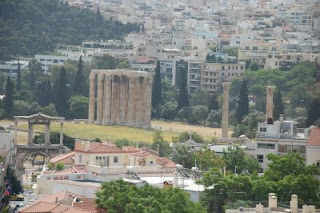I'm not really sure what I thought Athens would be like, but it wasn't quite what I'd expected. The city is extremely large, dirty, and loud. Our hotel was not in the best part of town, so I'm sure that had a little to do with our impression of the city. We buy a painting or drawing from a street artist everywhere we go, but we did not find street artists in Athens. We did, however, find shops with paintings...each shop with the exact same paintings all claiming to be unique...original! They then proceeded to charge absurd amounts of money for a copy! We were highly disappointed in the dishonesty and lack of choice, so we just ended up paying too much for an "original" copy. The people and dirtiness aside, the historical sites were incredible!
We explored the city our first evening in Athens and wondered around. We stumbled upon these steps, so we decided to go up them. The view of the city is beautiful! You can see the monuments, hills, mountains and bay from atop the hill. The light colored buildings seem to go on forever. We enjoyed an hour on the hill and decided to head back to the hotel before dark, since I was a bit scared of venturing into our temporary neighborhood at night. What we didn't know about the hill, was that it was the first location Apostle Paul preached the gospel in Greece! A-ma-zing!
We explored the city our first evening in Athens and wondered around. We stumbled upon these steps, so we decided to go up them. The view of the city is beautiful! You can see the monuments, hills, mountains and bay from atop the hill. The light colored buildings seem to go on forever. We enjoyed an hour on the hill and decided to head back to the hotel before dark, since I was a bit scared of venturing into our temporary neighborhood at night. What we didn't know about the hill, was that it was the first location Apostle Paul preached the gospel in Greece! A-ma-zing!


 And now the ruins!
And now the ruins!This arch was the main entrance to the Temple of Olympian Zeus. Construction of this temple began in the 6th century BC. The Athenian tyrants who built the temple had envisioned the building as the greatest temple in the ancient world. It took 400 years to build. It was the largest temple in Greece at the time and housed one of the largest cult statues in the ancient world.




 The Acropolis of Athens
The Acropolis of AthensThe Acropolis is a flat topped rock and artifacts from the Neolithic era have been excavated here. The grand marble entrance, the Propylaea, and the Erechtheum (the building with columns that look like women) were built in 400 BC. The hill was once full of temples, sanctuaries, and monuments all dedicated to the Greek gods.
View of the Acropolis from the site where St. Paul first preached the gospel in Athens.
 View of the Temple of Olympian Zeus as we walked to the Acropolis
View of the Temple of Olympian Zeus as we walked to the Acropolis Odeon of Herodes Atticus-theater. It was built in 161 AD by Herodes Atticus and was used for musical performances. There are still performances that take place there.
Odeon of Herodes Atticus-theater. It was built in 161 AD by Herodes Atticus and was used for musical performances. There are still performances that take place there. Theater of Dionysus. When it was first constructed, it could seat 17,000 people! It became the model for all theaters of ancient Greece.
Theater of Dionysus. When it was first constructed, it could seat 17,000 people! It became the model for all theaters of ancient Greece.

 Another view of the Odeon of Herodes Atticus
Another view of the Odeon of Herodes Atticus The Propylaea, main entrance
The Propylaea, main entrance The Parthenon
The ParthenonIt is considered the most important surviving building of Classical Greece. Built in 400 BC, it was used as a treasury. In the 6th century AD, it was converted into a Christian Church dedicated to the Virgin Mary. In the 1400's the Ottomans turned it into a mosque and it became a monument in the 1600s. Quite a bit of religious history!

 The Erechtheum
The ErechtheumLike the Parthenon, it went through a bit of transition over the centuries. It was originally a temple dedicated to Athena.
 Ancient Agora of Athens
Ancient Agora of AthensThe Agora was the marketplace and civic center of the ancient city of Athens. It is said that Greek democracy first came to life here at the Agora, which was the heart of Athenian life in Ancient Greece. The buildings of the Agora were destroyed by Persians in 480BC, and later by Romans in 86 BC.
The temple of Hephestsus (or Thesion) is best preserved temple of its time. It is a smaller version of the Parthenon.












No comments:
Post a Comment